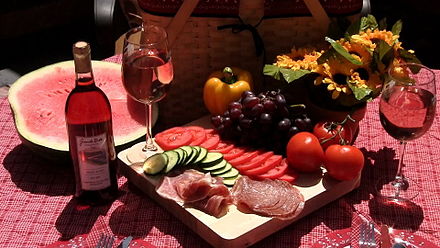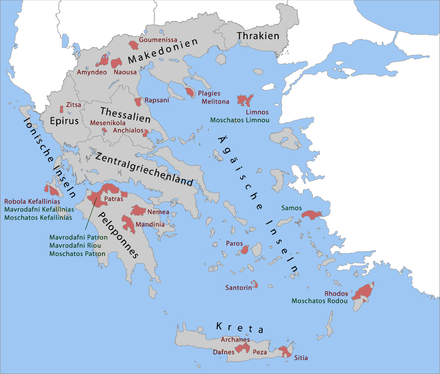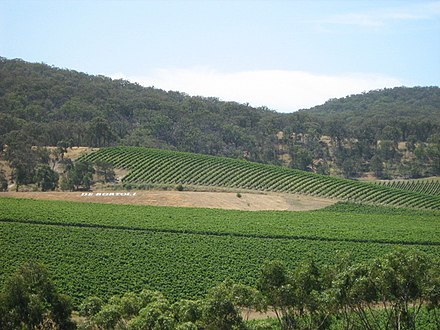Wine
Wine
 As wine is usually regarded as the most sophisticated of alcoholic beverages, wine tourism or enotourism is highly developed in many regions around the world, and it can be as simple as hopping on a wine shuttle in Napa Valley or as complicated as renting a villa in the south of France for a month. Enotourism is a great way to learn about the people, culture, heritage, and customs of an area. Some of the famous wine producing regions of the world have been producing wine for centuries or even millennia, and the production and consumption of wine is deeply ingrained in the local culture. Also, these areas tend to be off the beaten tourist track (although not that far off) so enotourism can expose travelers to new and interesting areas. Getting out and visiting wine producers provides contact with local farmers and artisans who care deeply about the area. Wine growers are farmers, and their perspective on the local area, and life in general, tends to be different from other locals typically encountered while traveling.
As wine is usually regarded as the most sophisticated of alcoholic beverages, wine tourism or enotourism is highly developed in many regions around the world, and it can be as simple as hopping on a wine shuttle in Napa Valley or as complicated as renting a villa in the south of France for a month. Enotourism is a great way to learn about the people, culture, heritage, and customs of an area. Some of the famous wine producing regions of the world have been producing wine for centuries or even millennia, and the production and consumption of wine is deeply ingrained in the local culture. Also, these areas tend to be off the beaten tourist track (although not that far off) so enotourism can expose travelers to new and interesting areas. Getting out and visiting wine producers provides contact with local farmers and artisans who care deeply about the area. Wine growers are farmers, and their perspective on the local area, and life in general, tends to be different from other locals typically encountered while traveling.
Understand
For the oenophile, enotourism is a wonderful way to better understand terroir, the difficult-to-define concept that wine makers often use to describe a key component of their art. Roughly speaking, it has to do with how the quality of the land in which the grapes are grown affects the taste of the wine. Tasting wine at a wine shop or in the comfort of home can provide a hint at the terroir that produced the wine. But spending several days visiting the area, chatting with the wine makers and growers, and eating the local cuisine (which has evolved together with the wine for the two to perfectly complement each other) will provide an exceptional context for the wine and give deep insight into why and how the wine turned out the way it did.
Wine is an important element in many European cuisines. Fine dining menus can have a recommended wine for each course.
See and do
The heart of enotourism is visiting wineries, and of course, tasting the wines.
Learn

The names of wines are often indicative of the area in which they are produced, with such usage often protected by law; for instance champagne can only be produced in the Champagne region of France, sherry can only be produced in Jerez de la Frontera, Spain, port wine can only be produced in the Douro Valley, Portugal, Chianti wines can only be produced in Chianti, Italy, and Tokaji can only produced in Tokaj, Hungary.
Destinations
Europe
Armenia
- Areni in Southern Armenia is the country's largest wine making region. The Areni-1 cave hosts the oldest known winery, dating back over 6,000 years.
- Togh in Nargorno Karabakh is also known for its wines
Bulgaria
- Moesia Danube plains Gamza
- Black sea coast Euxinograd wines
- Rose Valley Rossato
- Tracian plains Mavrud
- Struma Valley Broad Melnik vine
Croatia
Cyprus
Not only does winemaking on the Mediterranean island of Cyprus date back more than 5,000 years, but it has some of the prettiest high-altitude vineyards in all the world. Accommodation costs are particularly cheap by European standards in the north.
Czech Republic
France
See also: French cuisine
France is a traditional wine-growing country, with several very famous wine-growing regions, including the following:
- Alsace; see Alsatian Vineyard Route
- Burgundy
- Bordeaux (includes many appellations of the Gironde)
- Champagne
- Languedoc-Roussillon
- Loire Valley
- Provence
Many vineyards welcome visitors for wine-tastings.
Georgia
The earliest known evidence of winemaking, dating back to c. 6000 BCE, was found in Georgia.
Georgia and Moldova were renowned in the former USSR as the republics where great wine came from. As an independent country, Georgia's wines have had some wider distribution, some of it intercontinental.
- Kakheti — the primary Georgian wine country.
- Abkhazia — the break-away republic was particularly renowned for its wine back in the Soviet days, and still produces a rich selection of semi-dry and semi-sweet white and red varieties.
Germany
 See also: German beer and wine
See also: German beer and wine
Germany is better known as a beer-making country, but it is also famous for its wines, especially the Rieslings of the Rhineland-Palatinate. Germany is also known for its ice wines (German: Eiswein), in which the grapes used to make the wine are allowed to freeze on the vine in the winter before they are harvested.
- Rheinhessen: Müller-Thurgau, Riesling, Dornfelder, Silvaner, Portugieser, Kerner, Spätburgunder, Grauburgunder, Scheurebe
- Palatinate: Riesling, Dornfelder, Müller-Thurgau, Portugieser, Spätburgunder, Kerner, Grauburgunder, Weißburgunder
- Baden: Spätburgunder, Müller-Thurgau, Grauburgunder, Riesling, Weißburgunder, Gutedel
- Württemberg:Trollinger, Riesling, Schwarzriesling, Lemberger, Spätburgunder, Kerner
- Mosel:Riesling, Müller-Thurgau, Elbling, Kerner
- Franconia: Müller-Thurgau, Silvaner, Bacchus
- Nahe: Riesling, Müller-Thurgau, Dornfelder
- Rheingau: Riesling, Spätburgunder, Müller-Thurgau
- Saale-Unstrut: Müller-Thurgau, Weißburgunder, Silvaner
- Ahr: Spätburgunder, Riesling, Portugieser
- Saxony: Müller-Thurgau, Riesling, Weißburgunder
- Mittelrhein: Riesling, Spätburgunder, Müller-Thurgau
- Hessische Bergstraße: Riesling, Spätburgunder, Grauburgunder
Greece
 Ancient Greeks were known to be great wine lovers, and introduced grapevines and winemaking knowledge across the Mediterranean basin through their colonies.
Ancient Greeks were known to be great wine lovers, and introduced grapevines and winemaking knowledge across the Mediterranean basin through their colonies.
A local type not to be missed is retsina, Greek wine infused with pine resin. It originated from when wine amphorae were sealed with pine resin, to avoid the wine inside spoil by cutting it off the air, and the resin unintentionally infusing its flavor into the wine it is in contact with. The Romans started using barrels, so resin would no longer be necessary, however people liked the unique taste so much that retsina is still in production.
Prominent Greek wine regions include:
- Naousa — produces an award-winning red from a local cultivar.
- Samos — wine is the main agricultural product of this island, which holds a festival dedicated to it. Made of a Muscat variety, Samian wine is sweet.
- Santorini — vines are kept low in a basket shape so they can withstand the arid winds and poor soils in this volcanic island. Santorini wines have long been prized internationally, so much that the Russian Orthodox Church officially adopted it as the wine used in Holy Communion services in the Middle Ages.
Italy
 See also: Italian cuisine
See also: Italian cuisine
As in France, wine is a traditional product in Italy. It is produced virtually everywhere in the country, and this means no matter where you are going, you can combine your next trip to Italy with a bit of enotourism.
That said, if you're going specifically for the wine, there are some regions that stand out. If you use the awards given by the Italian wine bible Vini d'Italia as an indication, the three regions where the best wine is produced are Piedmont, Tuscany and Lombardy. They all have one particularly important subregion. For Piedmont it is Langhe, where among others the wines of Barolo and Barbaresco are produced. For Tuscany it is Chianti together with the towns of Montalcino and Montepulciano. For Lombardy it is Franciacorta where the homonimous sparkling wine is produced.
Enotourism is highly evolved in Italy, and many producers offer other services as well. Of particular importance is the agriturismo system of providing accommodation for tourists at the estate, making it easy to explore the surrounding region.
The event of Cantine Aperte on the last Sunday of May is a good opportunity for anyone interested in Italian wine. This is the day many wine producers throughout Italy open their doors for a free tasting of their wines.
Apulia (Puglia), in the south of Italy, is becoming renowned for its wines and land. More information can be found on the institutional website ViaggiareinPuglia.it. Rome's enotourism is also increased; the Roman Hills and Frascati are most enjoyable places.
Marsala (at Sicily island) is home of the famous Marsala wine, which is served as dessert and used in many recipes.
Hungary
- Tokaj is the focal point of the Tokaj-Hegyalja region, inscribed into the UNESCO World Heritage List for its winemaking tradition. The region extends across the border created after World War I into Slovakia; this part is known as Slovak Tokaj.
Moldova
Most of this country is a wine-growing area. Mileștii Mici winery has over 200 km of underground tunnels, some of which used to store the biggest wine collection in the world. Cricova winery, which has over 120 km of underground tunnels, is a favourite of tourists.
North Macedonia
- Tikveš in the southern Vardar Region is the Macedonian wine country. Kavadarci and Negotino are the main wine-producing towns, while Demir Kapija is the home of the royal winery of the former Kingdom of Yugoslavia.
Portugal
Russia
Russia isn't exactly known for its wine, and most of the consumption is imported from the ex-Soviet republics and elsewhere in Europe, but there are pockets in the southern fringes of the country where grapes thrive, and indeed support a wine industry.
- Krasnodar Krai — the region produces about half of the Russian wine by quantity alone.
- Rostov Oblast — the Don River region is one of the principal Russian wine areas.
- Crimea — the peninsula has been a wine-growing area since the days of the Romans, but most of the local wine is often found to be undrinkably sweet by those unaccustomed to it.
Spain
- La Rioja (Spain)
- Jerez de la Frontera - Famous for its sherry wines
Switzerland
The French-speaking part of the country, especially the canton of Valais and the region around Lake Geneva, is Switzerland's main wine producing area. The wine-growing terraces of Lavaux, with a history of viticulture since Roman times, are on UNESCO's World Heritage List.
Turkey
Turkey doesn't have officially recognized geographical appellations or terroir designations. With the exception of the north coast (which has a constantly rainy climate unfavorable to the ripening of wine grapes), all Turkish regions have wine production, although often in modest amounts compared to some of the neighbors. Below is a list of some areas better known for their winemaking, endowed with facilities to provide an insight for the enotourist:
- Bozcaada (Tenedos) — known for its wine for centuries (so much so that the local coins depicted grapes in ancient times), this Aegean island off the western coast still keeps the tradition
- Cappadocia — some of the best wines Turkey has to offer come from the volcanic sands of Cappadocia
- Şarköy District — also known as the Thracian wine coast, this 35-km stretch of hilly land fronting the Sea of Marmara supplies about half of the country's wine production. Major wineries in the district, as well as others in the surrounding region, are connected to each other by the Thracian Wine Route.
- Şirince — this pleasant historic village is famous for its homemade wines, as well as fruit-flavored ones
North America
Canada
- Okanagan Valley, British Columbia
- The principal Wine Regions of Ontario are the Niagara Peninsula, Prince Edward County and Essex County, with the former best known for its ice wines.
- Nova Scotia has a significant wine industry.
- There is some production in New Brunswick, Prince Edward Island, and the Eastern Townships of Québec
- Cypress Hills Winery in Saskatachewan claims to be the world's northernnmost winery. They make no grape wines, but use various fruits which will grow in their climate. See Cypress Hills Interprovincial Park for information on the region.
USA
See also: American cuisine
- Colorado's Wine Country, Colorado
- Finger Lakes, New York
- Livermore and Pleasanton, California
- Loudoun County, Virginia
- Napa Valley, California
- North Fork of Long Island, New York
- Russian River, California
- Sonoma County, California
- Swan Creek, North Carolina
- Walla Walla in the Columbia River Plateau of Washington
- Willamette Valley, Oregon
- Yadkin Valley, North Carolina
Oceania
Australia
See also: Australian cuisine#Alcoholic beverages
 Hunter Valley
Hunter Valley- Albany
- Barossa Valley
- Clare Valley
- McLaren Vale
- Mornington Peninsula
- Yarra Valley
- Margaret River
- Swan Valley
- Coonawarra
New Zealand
- Marlborough
- Nelson: although industrial quantities of Sauvignon Blanc are produced in its easterly neighbour, the boutique wines of this spectacularly scenic area have won many gold medals in international competitions. Austrian Herman Seifried, of the eponymous winery, was one of the pioneers in the renaissance of New Zealand viticulture.
Other parts of the world
- Cape Winelands, South Africa
- Galilee, Israel
- Golan Heights, Israel
- Bekaa Valley, Lebanon
- Mendoza, Argentina
- Chile is the other major wine producer in South America
- Yantai, China
- Katsunuma, Japan
Stay safe
Wine carries all the hazards of any other alcoholic beverage. Drinking water on the side might help against dehydration, and keep consumption at a modest level.
See also
Related: Agritourism
Related: Grape grazing in Australia
